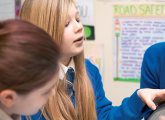Have students fundamentally changed? Prensky and his fellow digital evangelists certainly think so. Others argue that there is nothing new and the relationship between teacher and pupil remains a constant over time; it’s the environment and technology that alter. With each side failing to comprehend the vision and doubts of the other, we need to remember that there is light.
Consider this: I have used the Microsoft ‘track changes’ tool for years now to edit and annotate the work of students, and to submit MA essays and other writing to my proofreading friend, all with great success. Recently, a Y10 student, whose homework was to analyse a script he had written and explain his intentions, handed his work in similarly augmented. This is not the first time I have set students of all ages a task such as this, but it was a novelty for one of them so innovatively to provide me with annotation and comments. When I first looked at it, all I could think was that it was a perfect solution. It looked beautiful, laid out with clarity – no more wiggly lines and strange shadings.
Yours for the taking
There are infinite uses of ICT, many of which are not even explored yet and most of which are beyond the knowledge of one single person (it is estimated that only 10% of a programmes capacity is ever utilised by a particular individual and only slightly more by an entire organisation). Education professionals have to decide which combination of ICT uses and applications make best pedagogical practice, which digital strategy should be pursued, with how much investment and finally, which of these uses are going to be effective in the long term. In days gone by, answers to these questions could have been gleaned from those in senior positions and a pathway worked out and followed. However, instead of looking upward for a coherent all-encompassing solution – provided by those cleverer, wiser and more experienced than ourselves – we now need to look outward to the students and beyond them to the local community to turn ICT from being a problem to being a solution. So, feel empowered and with confidence step forward: take a tiny piece of ICT (equipment, programme, app or otherwise) no matter what it was designed for and use it as a solution to something that is pertinent to you; in your teaching, in your environment and in your vision.
The communication revolution has taken off and grown exponentially in recent years and the dizzying pace of technological change means that it is often difficult to keep up with emerging patterns of use amongst students and other professional organisations. School leaders are also in the dark as to the effectiveness of emergent technologies so often cannot lead confidently. This means that it is time for you – the classroom teacher – to lead from the bottom up and maximise the learning of the student in the classroom. It may sound daunting, but this really a wildly exciting time to be a teacher as horizons widen. It is with courage that we need to leave the stage and step down to guide our students in skills required to broaden their experience maximise their own learning and enhance their knowledge. It is also a time for teachers to learn, do things in a different way. Students love to share their knowledge with sad and desperately uncomprehending adults. These digital kids know how it works; this programme, that programme, that function, that shortcut, the best website - each has a personal favourite which he or she will be happy to recommend. Use rewards, set up a club or just ask, but make sure that somehow, you get the students to teach you things you can use in the classroom. The great thing about cyberspace is that it has the flavour of a great big playground and so experiments, models and roles can be tried out without breaking anything and no one being at risk.
Plus ça change…
Whilst the learning process and students have changed little over time and we are still required to inspire, impart and instruct, there is certaily a new literacy developing, which started with the advent of the mass media and mass communication and has been accelerating ever since. The move from simple print and image to the complex world of cyberspace has led to an environment that has more ‘constructedness’ about it than the straightforward communication in print literacy. The training of teachers does not as yet provide education in the new literacies as a matter of course, which means that existing teachers have a responsibility to try to guide students through this new world. We are no digital innocents, after all – we can all use the web and at least some of its functions, especially if we skill share and support each other. It is teachers who have to define this new pedagogy and the only way to do it is by practising and sharing the experience both negative and positive.
Much is talked of this new digital learner and how technology has changed him or her and inspired a new spontaneous engagement through technology with creativity and learning. However, study after study has shown this to be a myth and the so-called digital native has no marked improvement in the schooling process. As with all previous models of student behaviour the truly innovative, creative and independently engaged are in a minority. Whilst it may be true that, for the digital native cyberspace is their very own culture; we should also consider that it may be no more long lasting or intellectually important than the Charleston. There may be seam after seam of information and experience out there in the virtual universe, but if students do not have the tools to mine those seams with some degree of critical sensibility then that knowledge, as yet undiscovered, is useless. In that sense, then, the role of the teacher has changed little.
So, from your own knowledge, from the students, from Google, or from someone you’re following on Twitter, the trick is always to find something that solves a problem; appropriate it, take it, borrow it and use it to enhance teaching and learning. Thereby, making you a better teacher. And as we all know, regardless of the exponential rate at which technology is developing these days, ‘twas ever thus.
About the Author
David Milliken worked for a major international magazine before teaching media studies, English and drama for the last 20 years, he is a passionate advocate of the importance of multi-modal literacy and is currently studying at the IOE for an MA in ICT in education.











“Whilst it may be true that, for the digital native cyberspace is their very own culture; we should also consider that it may be no more long lasting or intellectually important than the…